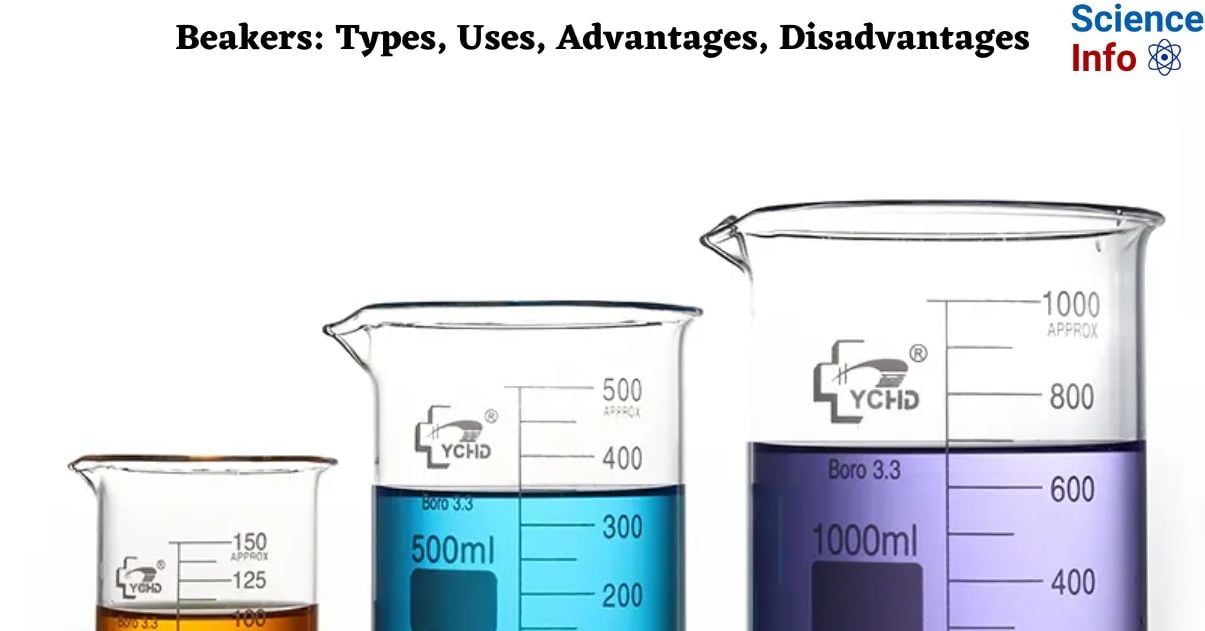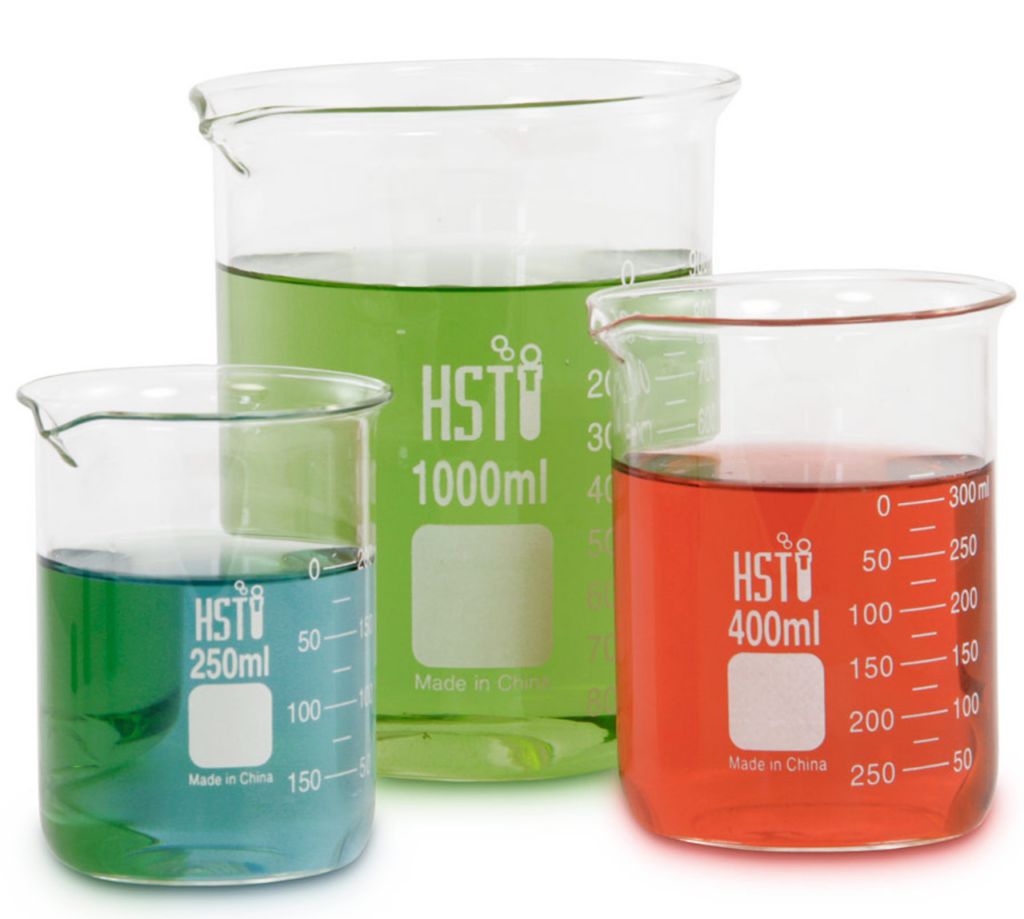Beakers are basic cylindrical containers with flat bottoms and a pouring lip. They come in a variety of sizes and materials. In the lab, beakers are used to stir, mix, measure, and heat liquids. Beakers come in a variety of sizes, with the most common being 50 ml, 100 ml, 250 ml, 500 ml, and 1000 mL. They can be made of glass or plastic, and some have graduated markings to help you measure liquids accurately. Glass beakers are favored in chemistry labs for their transparency and chemical resistance.

Interesting Science Videos
Beaker- Definition
Beakers, prevalent laboratory vessels, serve the purpose of preparing and containing diverse solutions and samples. Their standard design involves a cylindrical structure with a flat bottom and an open top, reminiscent of a cylindrical drinking beaker. Notably, the straight cylindrical sides distinguish them from flasks, which often feature conical or bulbous arrangements.
While the typical beaker maintains strict cylindrical symmetry, stackable variants may exhibit a slight incline to facilitate efficient stacking. Functionally, beakers are equipped with a spout to enable precise pouring, and many models incorporate graduated markings for approximate volume measurement.
Widely employed in chemical, biological, clinical, and industrial laboratories, beakers play a crucial role in facilitating fluid storage and mixing. Their application extends to various industrial testing environments, where their design proves advantageous. Overall, beakers stand as versatile and essential containers, contributing significantly to the fluid-handling aspects of laboratory and industrial operations.

Types of Beakers
Beaker Categories
- Griffin Beakers: Standard, with height about 40% of the diameter.
- Berzelius Beakers: Taller and thinner, with height double their diameter.
- Crystallizer Beakers: Typically without measuring marks, used for crystallization.
- Phillips Beakers: Resemble Griffin beakers but with sloping walls and graduated markings.
- Distinct Feature: Mouth is much more narrow than the base.
Beakers Based on Height and Shape
Low Form Beaker
- Characteristics: Short height, wide mouth.
- Purpose: Ideal for heating and mixing liquids.
Tall Form Beaker
- Characteristics: Taller height, narrower mouth.
- Purpose: Useful for holding and measuring larger volumes.
Florence Flask
- Characteristics: Narrow neck, round bottom.
- Purpose: Specifically designed for heating and mixing liquids.
- Characteristics: Conical shape, narrow neck, round bottom.
- Purpose: Commonly used for mixing and stirring liquids.
Graduate Cylinder
- Characteristics: Cylindrical shape.
- Purpose: Precision in measuring liquid volumes.
Funnel Beaker
- Characteristics: Wide top, narrow bottom.
- Purpose: Facilitates the transfer of liquids into containers with narrow openings.
Beakers Based on Raw Material
Glass Beakers
- Material: Borosilicate glass.
- Properties: Heat-resistant and chemically resistant.
Plastic Beakers
- Material: Lightweight and break-resistant plastic.
- Properties: Ideal for areas concerned with glass breakage.
Stainless Steel Beakers
- Material: Durable stainless steel.
- Properties: Resistant to corrosion, suitable for harsh laboratory environments.
Pyrex Beakers
- Material: Borosilicate glass (Pyrex).
- Properties: Specially designed for high-temperature applications.
Polypropylene Beakers
- Material: Lightweight polypropylene.
- Properties: Chemically resistant, suitable for laboratory use.
Teflon Beakers
- Material: Teflon (PTFE).
- Properties: Non-reactive and chemically resistant, ideal for harsh chemical environments.
Uses of Beakers
- Mixing and Preparing Reagents: Beakers are used to dissolve particles and combine liquids for various studies. They play an important role in preparing reagents for various analytical processes.
- Analytical Methods and Chemical Handling: Titrations are conducted using beakers, which allow for more precise chemical tests. Beakers allow for the safe handling of caustic chemicals during studies.
- Sampling, Capture, and Storage: Beakers are used to gather liquid samples from reactions for further analysis. They capture reaction products, making them easier to observe and analyze. Beakers are used for the short-term storage and transportation of liquids.
- Measuring Liquids: While not designed for precision, beakers are utilized to estimate volumes of liquids in laboratory settings.
- Heating or Cooling Liquids: Beakers can withstand temperature changes, making them suitable for heating or cooling liquids during experiments.
- Titration: Beakers play a crucial role in titrations, a chemical analysis method involving the controlled addition of a reagent to a solution.
- Observing Chemical Reactions: Transparent beakers allow researchers to observe changes in color or texture during chemical reactions.
- Transferring Liquids: Beakers serve as practical tools for transferring small amounts of liquid between containers.
- Dispensing Liquids: Beakers with a spout enable controlled dispensing of liquids, enhancing precision in experimental procedures.
Broad Applications in Scientific Laboratories
- Reaction Containers: Beakers function as versatile containers for holding solid or liquid samples during chemical reactions.
- Stirring Liquids: Essential for stirring liquids to prepare reagents or chemicals for experimental procedures.
- Titration Experiments: Berzelius beakers are specifically employed in titration experiments, generating diverse chemical outcomes.
- Hot Bath Heating: Flat-form beakers find application in hot bath heating procedures within scientific laboratories.
- Gamma Spectral Analysis: Plastic beakers are utilized in experiments such as gamma spectral analysis, showcasing the diverse applications of beakers in scientific research.
Advantages of Beakers
- Common Lab Equipment: Beakers are the most commonly available laboratory glassware, ensuring widespread accessibility.
- Versatile Sizes and Shapes: Available in a diverse range of volume capacities, sizes, and shapes, offering versatility for various experimental requirements.
- Flexible Volume Calculation: Beakers can approximate liquid volume when precise measurements are not critical, providing flexibility in experimental setups.
- Ease of Use in Processes: Facilitates straightforward use in stirring and heating processes, contributing to the efficiency of laboratory procedures.
- Pouring Convenience: Equipped with a spout for easy and controlled pouring during experimental tasks.
Disadvantages of Beakers
- Limited Precision in Measurements: Not suitable for precise measurements due to their design, making them unsuitable for tasks requiring high accuracy.
- Evaporation Concerns: The wide mouth of beakers can lead to faster evaporation/vaporization during experiments, affecting experimental conditions.
- Spillage Risk during Swirling: The straight surface with a wide mouth increases the risk of spillage, impacting the accuracy of experimental outcomes.
- Lack of Tight Lid: Beakers lack a tight lid, which may result in spillage or contamination in certain experimental conditions.
- Inaccuracy in Volume Measurement: Measuring the exact volume of a solution in a beaker is not precise; separate measuring tools like graduated cylinders should be considered for accuracy.
References
- https://microbiozindia.com/exploring-the-different-types-of-beakers-and-their-uses/
- https://www.scienceequip.com.au/blogs/news/measuring-cylinders-vs-beakers-pros-cons-of-common-lab-glassware
- https://www.globalspec.com/learnmore/labware_scientific_instruments/labware_consumables/beakers
- https://certifiedmtp.com/blog?p=everything-you-need-to-know-about-beakers-in-chemistry
- https://www.rdworldonline.com/what-are-beakers/
- https://microbiologynote.com/beaker-definition-types-features-and-applications/#Types_of_Beakers_Based_on_their_Height_and_Shape
- https://microbeonline.com/beaker-features-types-and-applications/
